
Lift tips: Strategies to stay at the top of your lift-game
By Canadian Rental Staff
Features genie ipaf ISO 18878 Kevin Spencer lift productivity lifts Neil Gerrard Stefan BekeStrategies to stay at the top of your lift-game
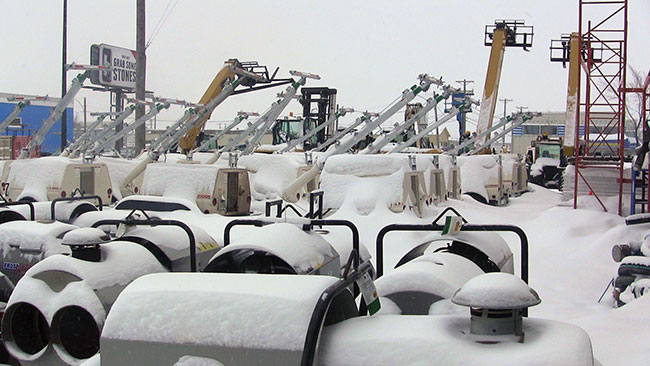 What a normal day in March in Saskatchewan looks like.
What a normal day in March in Saskatchewan looks like.
Every equipment purchase should be a smart investment. Selecting the right lift for your rental business contributes to the bottom line. Why not extract maximum life and productivity out of it through proper maintenance and handling as well? Here are some expert tips to stay ahead of the curve.
Arctic blast
By Matt Molnar, product support specialist at Genie
For the northern two-thirds of the U.S. and Canada, November signals the beginning of the season where some special steps must be taken to prepare the equipment for cold-weather work. When the snow flies, construction activity slows, but it doesn’t stop. Contractors depend on rental companies to have reliable equipment field-ready so that they can complete their winter projects on schedule. In addition to routine maintenance items, there are some extra steps the service technician should take in order to keep your rental fleet in the field and out of the shop over the winter.
Allow the equipment to warm up at the beginning of the day. Workers and equipment alike need an opportunity to warm up before going full speed in subfreezing temperatures. Allowing the equipment to properly warm up gives the oil a chance to flow through the system and heat up hydraulic components. Additionally, the engine and transmission function better if given ample time to warm up before using.
Check batteries for proper capacity and the ability to operate in cold temperatures. Dead batteries or those with low acid levels will freeze and not allow the equipment perform up to its standards in cold weather. Also, grease and lubricate all moving components. Water can penetrate seals and bushings and, once it freezes, can crack machine components. Thorough greasing and lubrication greatly reduce the chance of water penetration to sensitive areas of the machine.
For extreme cold weather applications, change to specialty oils in your machines. Several “Arctic oil” options are available on the market for sub-zero operation. Make sure to select the correct oil viscosity for the temperature range in which the equipment will operate. Select cold-weather package options for equipment. Block heaters, battery blankets and hydraulic tank heaters are available for extreme cold temperature operation. Inspect cold-weather package items frequently for proper operation.
Following these maintenance tips will help your machine deliver consistent and reliable operation during the winter months for your customers.
Evaluating the right mix
By Kevin Spencer, Genie used equipment sales manager
The 1990s saw an explosion in the popularity of self-propelled mobile elevated work platforms on construction and facilities jobsites. Since that time, MEWPs have shown a much longer lifespan in the secondary market. This has led to an increase in the confidence of used equipment – positively affecting demand. Today, rental business owners assess the right mix of both used and new equipment for their fleets.
Why did used equipment see an increase in popularity? In part, this is due to advancements in the design engineering of the equipment. Custom factory-fitted aerial components have been rapidly developed due to the substantial size of the new aerials market with a focus on improved performance. Engines, valves, pumps and drive motors, as examples, all started to become more durable in aerial applications and helped to extend the life of the equipment.
Historical concerns over reliability and cost of ownership slowly eroded as OEM component manufacturers also began to provide parts for legacy and discontinued aerial models. This was again due to the large number of the units still operating in the field. Over time, fleet owners have become less concerned about the risk of scrapping older equipment models due to a relatively inexpensive item, like a $100-200 valve section, that they previously had not been able to source. Today, fleet owners have much greater confidence that their aerial equipment will be supported throughout its lifespan by the OEM.
It is important to note, that no matter how well a MEWP is taken care of, at some point maintenance costs will increase, and a new or reconditioned machine may provide a better rental return on invested capital. As a fleet owner, you need to know your local customers’ preferences regarding age and condition of aerial equipment and weigh that against up market demand.
When it’s time to make the decision to replace older, used equipment, you have two options to consider: Purchase new or invest in reconditioned. How do you know which choice is best for your rental business?
When considering purchasing new, it is important to understand what advantages these MEWPs offer you and your customers. New high technology features, such as cycle speed, secondary operator protection and fuel efficiency, can be attractive to rental customers looking to enhance their productivity in certain applications. For example, the speed of operation of newer equipment is crucial when completing cycle-heavy applications, like window installation. Also, it is important to consider features, such as new secondary guarding accessories, like the Genie Lift Guard Contact Alarm, back-up cameras, envelope controls and anti-collision alarms to be incorporated into your fleets. For instance, many of these features and technologies are now mandated by contractors or specific jobsite regulations, while others are not. Newer engine designs, especially hybrid or electric drives, as another example, are important for jobsites in environmentally sensitive areas.
If new technology or features are a lower priority, reconditioned equipment may be a good alternative to consider. Reconditioned equipment, updated and certified by the OEM, can cover everything from the hydraulic, mechanical and electrical systems to steel covers, engine components, decals and manuals. The financial benefits of investing in reconditioned equipment have quickly caught on as fleet owners see the value add to their bottom line. As an example, a new MEWP might cost $90,000 and come with a 60-month payment schedule, repaying at $1,500 a month and providing $2,300 in rental. Rather than purchase a new MEWP, a 10-year-old certified reconditioned unit could be purchased at 65 percent of the new equipment rate. Your payments would be less yet the MEWP would still maintain the $2,300 in rental revenue. This means that you could pocket $500 more per unit per month. This has prompted many rental companies to mix their fleets with 10 to 15 percent of reconditioned equipment, which translates to huge benefits to their bottom line.
The right mix of new, reconditioned and used aerial equipment for your fleet will be specific to your rental business. As you are weighing these decisions, it is important to carefully balance the opinions of your key customers with the supply-demand scenario of your local rental market. This will give you a clear indication as to whether you will be able to get the same rate for a reliable machine, regardless of its age. After that, it is good to consult your tax professional about how to maximize the benefits of, as well as to reduce the risks of, different acquisition costs, finance rates and new tax laws that incentivize equipment purchasing decisions.
The engineer’s part in productivity
Belgian company TVH has two main strands to its business – selling parts and equipment for MEWPs and other machines, and a rental department with 4,500 machines in Belgium alone and an estimated 65,000 worldwide. Those complementary arms give the firm’s co-ordinator of technical trainings Stefan Beke an insight into another way to ensure that powered access equipment is as efficient as it can possibly be – maintenance and repair.
“IPAF is focused on operator training because we want people to be trained to use this kind of machine and then on the manufacturers’ side of things, they want to make machines that are as dummy-proof as possible,” says Beke. “But safety features can only operate correctly if they are checked, maintained and calibrated properly.”
Nonetheless TVH noticed that when it sent engineers out to undertake repairs, dispatchers tended to look geographically for the closest person. That resulted in a fair bit of rework, with the first engineer to visit often not being familiar with the machine in question.
This has led TVH to change its training, shifting from “open” theoretical-based training to much more practical training ending in theoretical and practical tests, combined with a new competency matrix of engineers to make sure that the right person has been sent to the right job. Meanwhile, clever use of technology also plays a part. TVH uses GPS trackers not just to keep an eye on its machines’ locations but also to monitor running hours of the engine or pump hours if it is an electric machine.
“We can avoid downtime with pre-hire and post-hire inspections and with the GPS we can see how much a machine has been operated and if maintenance is due we can endure that machine doesn’t go out on hire,” Beke adds.
Levelling up on productivity
By Neil Gerrard, IPAF
How many workers does it take to change a lightbulb? Contrary to what you might expect, this isn’t the prelude to a corny punchline. Instead, it’s key to demonstrating just how much more productive it can be to use powered access equipment than other work-at-height alternatives. That’s because there is more than one answer to the question depending on the tools you use, as manufacturer Genie demonstrated recently when it undertook an exercise to show why it makes sense to specify a mobile elevating work platform on a jobsite rather than scaffolding.
When it came to lighting maintenance work (not necessarily changing a lightbulb but close enough for the sake of our drawn-out analogy), Genie found that it took four people a total of 49 minutes to complete their task. The same task with a MEWP required just two workers, and they were all finished in 20 minutes. This was no fluke. Genie performed a similar test with pillar painting work and found that scaffolding needed the involvement of four workers who took three hours and 32 minutes to complete their task, compared to two workers taking just two hours and 21 minutes on a MEWP. High wall surface cleaning work took four workers three hours and six minutes, whereas a MEWP saw the job finished by two workers in the significantly faster time of one hour and 43 minutes.
The figures were no surprise to Steve Simmons, joint managing director of Star Platforms, which specialises in low-level platform, scissor lift and cherry picker hire. “As with most access platforms, the low-level access range of machines are safer, faster and more cost efficient than traditional scaffold towers, podium steps and ladders,” he says. “Their compact form means they can get into the tightest of spaces and, being lightweight, they can also be taken into elevators, making them ideal for the construction and maintenance of multi-storey buildings such as office blocks.” Simmons points out that a low-level powered access machine is also ready to use immediately as soon as it is in position, whereas a traditional aluminium scaffold tower requires several separate components to be carried into the work area, then erected and dismantled. Even once erected, workers find themselves climbing up and down them repeatedly to complete their task, taking up time, increasing labour and potentially increasing the levels of fatigue workers experience.
“With low-level access you simply get into the platform and elevate, which is much more time, cost and energy efficient,” Simmons says. “Low-level access is also far safer, minimising the risk of trips and falls compared to climbing towers or using step ladders or podium steps. Also, components of tower scaffolds often get lost or stolen, leading to additional charges for rental customers, which is usually avoided with the use of low-level platforms.”
Nationwide Platforms also points to similar inefficiencies when it comes to solutions such as scaffolding, as well as steps, ladders and alloy towers. Many buildings are now designed to be constructed and maintained to use powered access equipment where there is commercial pressure to reduce project length and cost is a significant factor. Although it isn’t just in construction where they can make a significant difference to productivity – areas such as TV broadcasting and film, aviation, surveying, sign repair and installation, and industrial maintenance can all benefit too.
Nationwide recently developed a ‘proof of concept’ to replace traditional scaffolding with its selection of powered access equipment in conjunction with Balfour Beatty. National Grid undertook a site survey on a 15-storey building and found that various riser pipes needed to be replaced urgently. Normally, the project would have involved the use of scaffolding around the building but instead site manager Terence Mahoney chose a 70-metre truck mount supplied by Nationwide Platforms to perform the work. The result, Mahoney says, was a £60,000 saving. “Plus, it removed the need for fixed scaffolding, which would have caused damage to the building,” he adds. “Essentially, using powered access helps us get the job done safely and quickly.” The test led to powered access being used on a further 16 National Grid projects last year. Contractor ISG, which specialises in building fitouts, has also undergone its own conversion to the efficiency of powered access. It undertook a study on a project where it used traditional access equipment on one floor, and Pecolift low-level access platforms with a reach of up to 4.2m on another. The secure platform permits working in a full 360-degree range, while keeping both hands free. ISG discovered that the machines, although more expensive, were 20 percent faster and boosted productivity.
IPAF’s training manager Paul Roddis, who previously worked as a training manager at HSS, has seen first-hand how much more labour-intensive scaffold towers can be as opposed to powered access. “If you want to use an aluminum scaffold tower, it requires two people to build it and they have a maximum freestanding height of about 10m. Then if you want to move it, you require two people to reduce its height, move it, and then put it together again. Plus, platform heights can only be set at certain levels, whereas powered access is infinitely variable. So powered access is much quicker,” he explains.
But the capabilities of the machines themselves shouldn’t be viewed in isolation, Roddis stresses. Core to using powered access productively – and above all safely – is ensuring that the operator is capable, and that’s where good training is key. IPAF’s standard operator training course conforms with ISO 18878 and beyond that there is its IPAF PAL+ course for advanced operators.
“IPAF PAL+ is designed for people who are working in more challenging and potentially more hazardous environments. Once people have practised and achieved what they need to achieve to pass this training, it makes them far more productive and far less likely to potentially collide with anything or put themselves at risk. It puts them in exactly the right position they need to be in in order to be able to work properly and get the most effective use out of what is the most efficient machine,” he says. There are interesting changes on the horizon that promise even greater productivity too. The manufacturing standard for MEWPs in Europe, EN 280, will soon see the introduction of a part two that deals with lifting devices. Potentially, this means that materials can be lifted using a powered access machine equipped with a lifting tool, as opposed to employing a second device to do this, as is currently the case.
Back to the setup for our non-joke about changing a lightbulb, perhaps the question should be “How many trained workers does it take?” Provided they are using powered access, the punchline is that it need take only one.
The last section has been reprinted with permission from IPAF.
Print this page
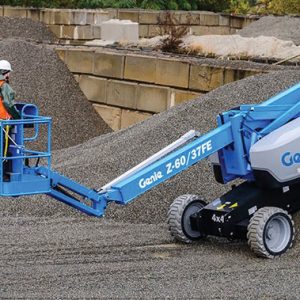
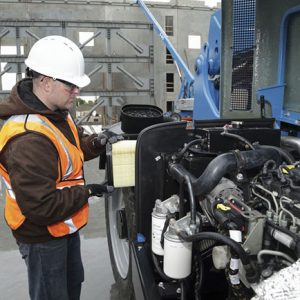
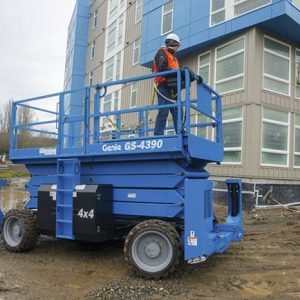
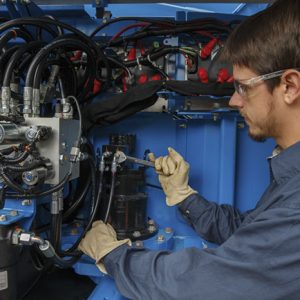
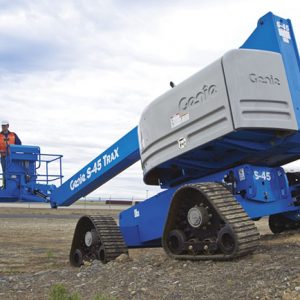
Leave a Reply